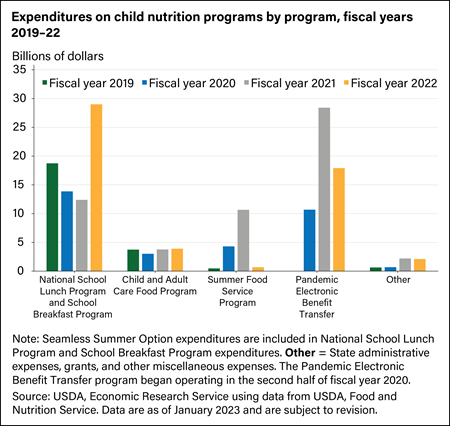
Child Nutrition Programs
USDA's child nutrition programs help ensure that children receive nutritious meals and snacks that promote their health and educational readiness. The child nutrition programs are administered by USDA's Food and Nutrition Service (FNS). In fiscal year (FY) 2019 (before the Coronavirus (COVID-19) pandemic), total expenditures (including administrative expenses, grants, and other miscellaneous expenses) on these programs amounted to $23.6 billion, the bulk of which were spent on the National School Lunch Program and the School Breakfast Program.
The onset of the pandemic in the second half of FY 2020 disrupted the operation of these programs. In response to these disruptions and to meet rising food needs during the pandemic, USDA issued waivers allowing for flexibilities in the implementation of its child nutrition programs and expanded the scope of both the National School Lunch Program’s and School Breakfast Program’s Seamless Summer Option, as well as the scope of the Summer Food Service Program. Total expenditures on Child Nutrition Programs declined to $21.9 billion in FY 2020, before increasing to $29.0 billion in FY 2021 and $35.7 billion in FY 2022.
Additionally, USDA implemented a new, temporary program in FY 2020 - Pandemic Electronic Benefits Transfer (P-EBT). Initially, the program reimbursed families with school-aged children eligible for free or reduced-price school meals (i.e., those from families with household incomes below 185 percent of the Federal poverty line) for the value of school meals missed due to pandemic related disruptions to in-person instruction at schools. Changes in FY 2021 and FY 2022 expanded the program to include more children and to cover the summer months when most schools are typically closed for instruction. Expenditures on this program amounted to nearly $10.7 billion in FY 2020, $28.4 billion in FY 2021, and $17.9 billion in FY 2022. To learn more about these pandemic-era changes, please see:
- The Food and Nutrition Assistance Landscape: Fiscal Year 2020 Annual Report
- The Food and Nutrition Assistance Landscape: Fiscal Year 2021 Annual Report
- The Food and Nutrition Assistance Landscape: Fiscal Year 2022 Annual Report
- COVID-19 Working Paper: Filling the Pandemic Meal Gap: Disruptions to Child Nutrition Programs and Expansion of Free Meal Sites in the Early Months of the Pandemic
Participation in USDA’s child nutrition programs has been found to reduce food insecurity. To learn more, please see:
For more information on specific child nutrition programs, please see:
- National School Lunch Program
- School Breakfast Program
- Child and Adult Care Food Program
- Summer Food Service Program
- After-School Snacks and Meals
All figures are based on data available as of January 2023 and are subject to revision.
For information on updates to these programs during the COVID-19 pandemic, see FNS Responds to COVID-19.
Additional studies and information about program eligibility requirements, benefits, and application processes are available from the Food and Nutrition Service Child Nutrition Programs web page.
Download chart data in Excel format


